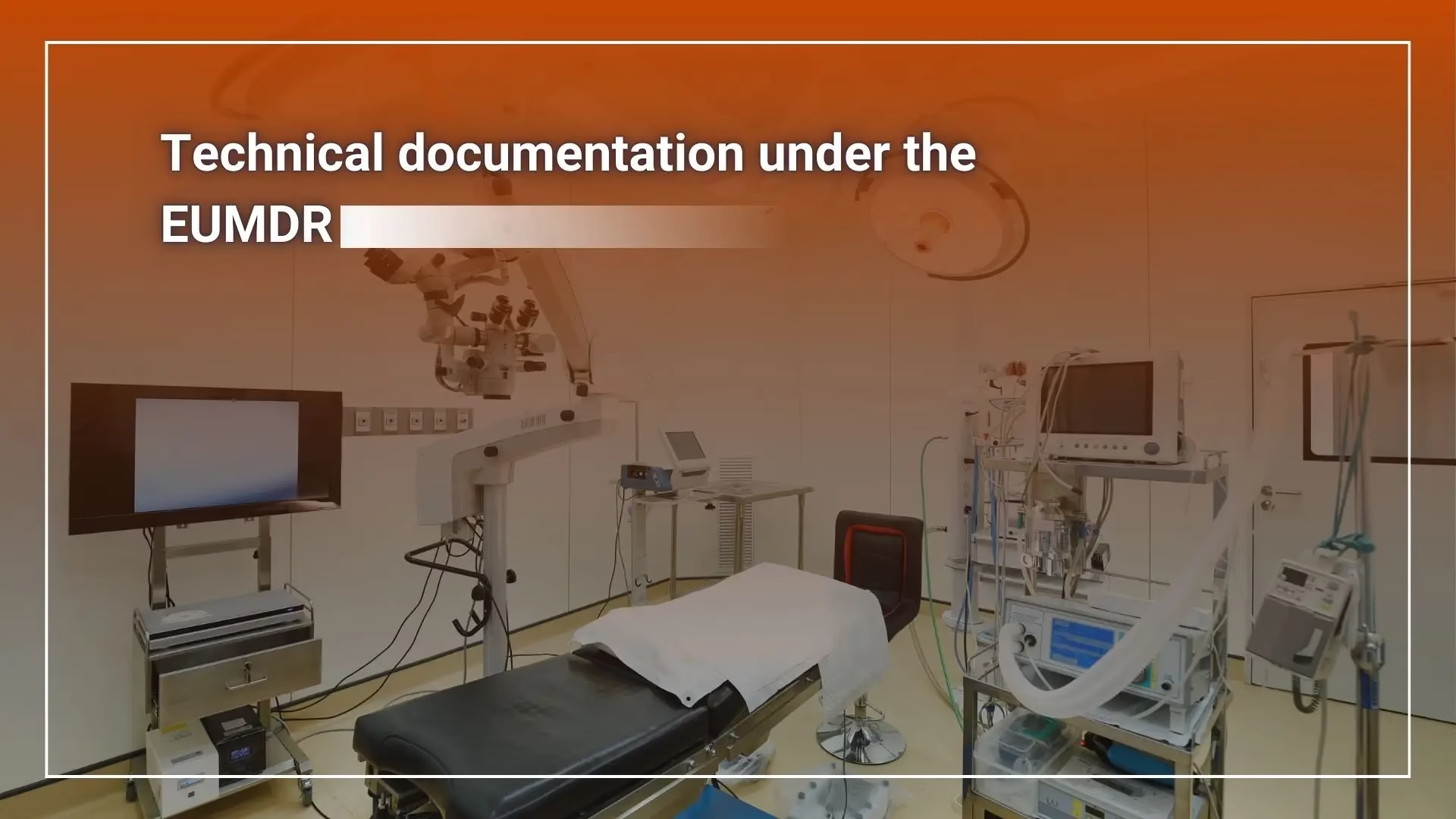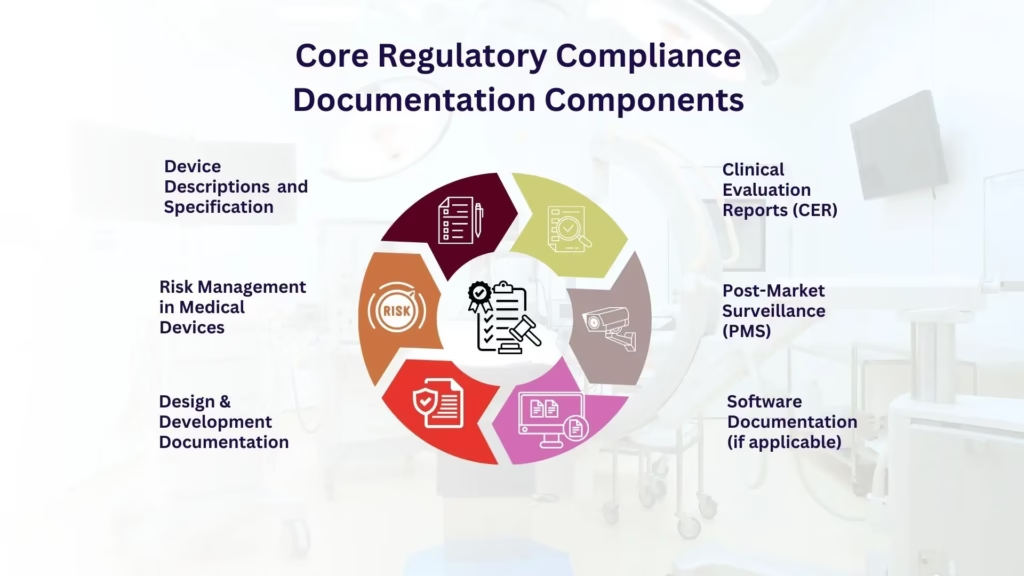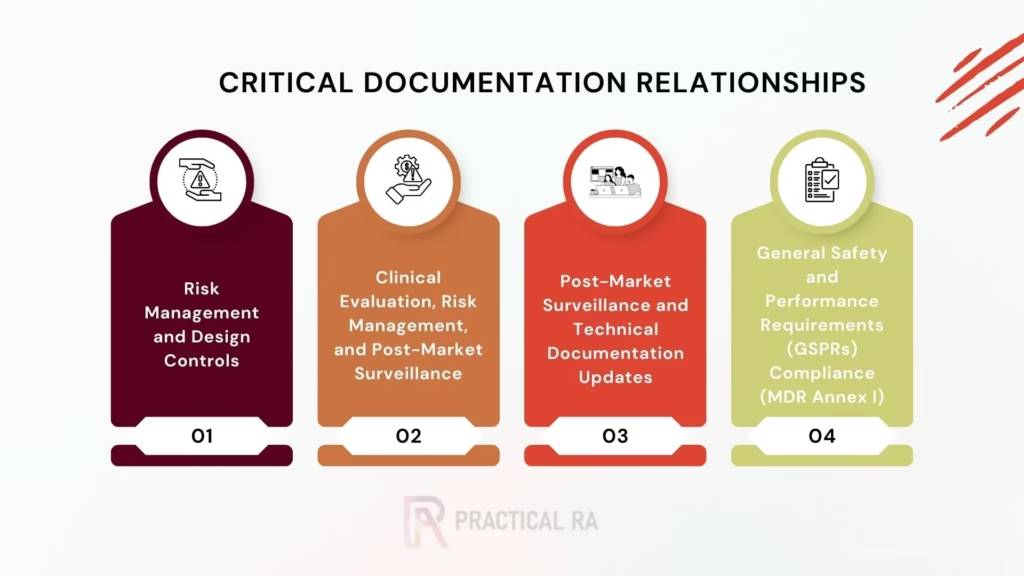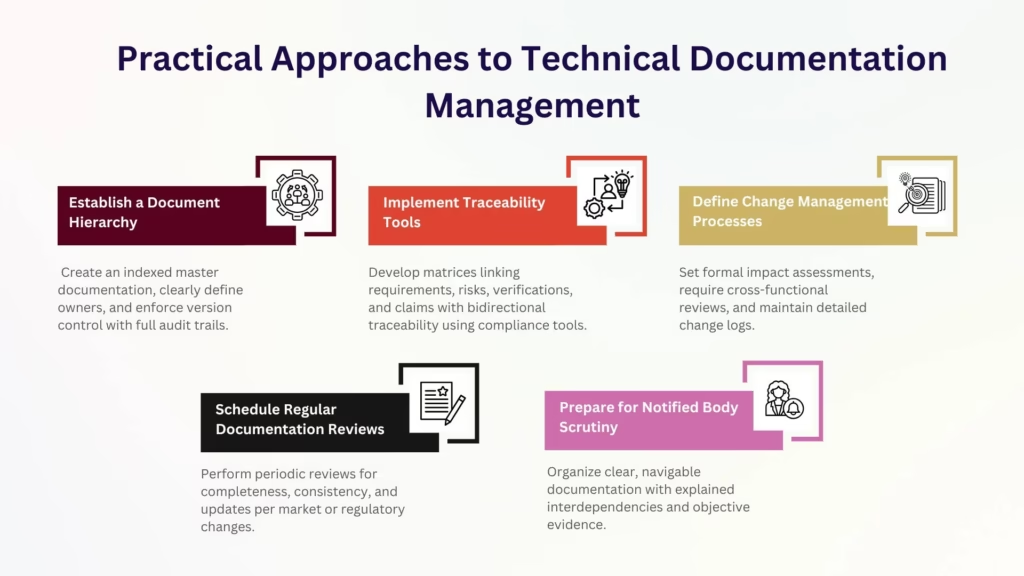Your basket is currently empty!

Technical documentation under the EUMDR
The Evolving Landscape of European Medical Device Regulatory Affairs: Navigating EU MDR 2017/745 Requirements
For professionals in regulatory affairs or innovative MedTech companies, understanding the European Medical Device Regulation (MDR 2017/745) represents a critical competency in today’s global healthcare market. The implementation of the EU MDR marked a significant shift from the previous Medical Device Directives (MDD), introducing more stringent requirements for technical documentation. For anyone seeking to enter the European market or to enhance their expertise through regulatory affairs courses online or medical device training courses, understanding these changes is essential for maintaining market access and ensuring patient safety.
The new regulation emphasizes a lifecycle approach to medical device regulation, requiring manufacturers to implement more robust systems for documentation management from initial design through post-market surveillance. This approach aligns with global medical device regulation trends that prioritize continuous assessment of benefit-risk profiles throughout a product’s commercial life.
Essential Technical Documentation for Medical Device Regulatory Affairs
Medical device regulatory affairs professionals must navigate an interconnected ecosystem of documentation that demonstrates compliance with EU MDR requirements. This documentation forms the backbone of any regulatory submission and subsequent market surveillance activities. Annex II of the MDR describes the key elements that form the EU technical documentation.
Core Regulatory Compliance Documentation Components

1. Device Descriptions & Specification
The device description serves as the cornerstone for all medical device regulatory submissions and provides the foundation upon which all other technical documentation is built. This documentation:
- Defines the device’s intended purpose, target user population, and principles of operation
- Outlines all device variants, accessories, and compatible components
- Establishes the regulatory classification in accordance with MDR Annex VIII
- Specifies materials, components, and functional characteristics
This documentation must be detailed enough to allow for a complete understanding of the device while remaining consistent with claims made in marketing materials, instructions for use, and clinical evaluation reports. A Notified Body reviewer will rely on this description to understand the device’s principles of operation and relevant regulatory requirements. Advanced medical device regulatory training often emphasizes the importance of maintaining consistency across all documentation types.
2. Risk Management in Medical Devices
The risk management file documents the manufacturer’s compliance with ISO 14971, the international standard for risk management in medical devices. This critical documentation:
- Captures the entire risk management process from hazard identification to residual risk evaluation
- Establishes risk control measures that directly influence design specifications
- Provides justification for design decisions based on risk-benefit analyses
- Requires continuous updating as new information becomes available through post-market activities
EU MDR training courses emphasize that risk management is not a one-time activity but a continuous process that spans the entire device lifecycle. Unlike previous regulatory frameworks, the MDR explicitly requires manufacturers to update risk documentation based on real-world performance data, creating a dynamic rather than static approach to device safety.
3. Design & Development Documentation
Design and development files provide evidence that the medical device was developed according to well-defined procedures and meets its intended purpose. This documentation:
- Demonstrates how user needs were translated into design requirements
- Provides verification evidence that design outputs meet design inputs
- Documents validation activities confirming the device meets user needs
- Establishes traceability throughout the design process
For professionals in medical device compliance roles, maintaining robust design control documentation is fundamental to demonstrating that devices have been developed using sound engineering practices. Regulatory affairs courses often include detailed modules on design control processes and documentation requirements for both EU MDR and US FDA submissions.
4. Clinical Evaluation Reports (CER)
The Clinical Evaluation Report represents one of the most significantly enhanced requirements under the EU MDR compared to previous regulations. This critical documentation:
- Synthesizes and evaluates all available clinical data relevant to the device
- Provides evidence-based confirmation of clinical performance and safety
- Demonstrates compliance with relevant GSPRs related to clinical benefits
- Establishes ongoing clinical data collection requirements post-certification
Clinical Evaluation Reports training has become a specialized area within medical device regulatory affairs, as the MDR requires more rigorous clinical evidence than previous regulations. The CER must demonstrate a favourable benefit-risk determination based on scientific validity and current state of the art, with clearly defined clinical benefits weighed against potential risks.
5. Post-Market Surveillance (PMS)
Post-market surveillance documentation outlines the manufacturer’s system for actively collecting and analyzing experience gained from devices on the market. This documentation:
- Specifies methods for gathering real-world performance data
- Establishes thresholds for potential safety signals requiring action
- Outlines processes for implementing design or manufacturing changes based on field data
- Integrates with the risk management system to evaluate emerging risks
Post-market surveillance courses and trainings have increased dramatically with the implementation of the EU MDR, as this regulation places unprecedented emphasis on the proactive collection of post-market data. The PMS plan must be tailored to the specific device, its risk profile, and its expected lifetime, making it impossible to apply a one-size-fits-all approach to this documentation. The new requirements also give rise to more detailed follow-up, including Post-Market Surveillance Reports (PMS Reports) or Periodic Safety Update Reports (PSURs). PMS also encompasses the scope of Post-Market Clinical Follow-Up (PMCF) activities, which are now expected for all device classifications under the MDR.
6. Software Documentation (if applicable)
For devices incorporating software, additional documentation requirements apply under EU MDR. These are generally aligned with US FDA frameworks. This specialized documentation:
- Details the software development lifecycle and architecture
- Provides evidence of software verification and validation
- Addresses cybersecurity risks and controls throughout the product lifecycle
- Specifies processes for software updates and patch management
As healthcare becomes increasingly digitized, regulatory submission software and specialized training on software documentation requirements have become essential tools for regulatory professionals managing software-enabled medical devices. This extends to software as a medical device (SaMD), including mobile apps and user portals.
Navigating Document Interdependencies in Medical Device Compliance
The challenge in medical device regulatory compliance isn’t just producing individual documents but managing their complex interdependencies. A comprehensive understanding of these connections is essential for maintaining compliance throughout the product lifecycle:
Critical Documentation Relationships

1. Risk Management and Design Controls
- Each identified risk must have corresponding control measures implemented in the design
- Design changes must be evaluated for their impact on the risk profile
- Verification testing must validate the effectiveness of risk control measures
2. Clinical Evaluation, Risk Management, and Post-Market Surveillance
- Clinical data must support risk-benefit determinations
- Residual risks identified during risk assessment must be addressed in clinical evaluations
- New clinical findings from post-market surveillance must trigger reassessment of the risk management file and comparison to the current state of the art
3. Post-Market Surveillance and Technical Documentation Updates
- Field data must feed back into risk assessments and clinical evaluations
- Significant findings require updates to relevant technical documentation
- Trend analysis may necessitate changes to warnings, contraindications, or instructions for use
4. General Safety and Performance Requirements (GSPRs) Compliance (MDR Annex I)
- Each applicable GSPR must be addressed through design, risk controls, or clinical data
- Documentation must establish complete traceability between requirements and evidence
- Any exemptions must be thoroughly justified with risk assessments
For professionals seeking basic medical device regulations training or introductory medical device compliance courses, understanding these interdependencies provides an essential foundation for effective regulatory management.
Practical Approaches to Technical Documentation Management

Maintaining compliant technical documentation requires robust systems and processes. Regulatory affairs online programs increasingly focus on these practical aspects of documentation management:
1. Establish a Document Hierarchy
- Create a master technical documentation index identifying all components
- Clearly define document owners and approval authorities
- Implement version control systems with full audit trail capabilities
2. Implement Traceability Tools
- Develop matrices connecting requirements, risks, verification activities, and claims
- Maintain bidirectional traceability between linked documentation elements
- Use regulatory compliance tools to automate traceability where possible
3. Define Change Management Processes
- Establish formal impact assessment procedures for all document changes
- Require cross-functional review of changes to identify downstream effects
- Maintain detailed change logs documenting rationales and approvals
4. Schedule Regular Documentation Reviews
- Conduct periodic assessments of technical documentation completeness
- Verify alignment between linked documents for consistency
- Update documentation based on new market information or regulatory changes
5. Prepare for Notified Body Scrutiny
- Organize documentation in a logical, easily navigable structure
- Provide clear explanations of document interdependencies
- Ensure all assertions are supported by objective evidence
EU MDR Introductory Courses increasingly emphasize these practical aspects of documentation management as critical success factors in regulatory submissions.
Global Considerations: Beyond EU MDR
While this guide focuses primarily on EU MDR requirements, regulatory affairs professionals must often navigate multiple regulatory frameworks simultaneously. Key considerations for global documentation strategies centre around harmonising Documentation across markets, including:
1. Leveraging International Standards
- Utilise ISO 14971, ISO 13485, and other harmonised standards as the foundation for documentation
- Structure technical documentation to address multiple markets’ requirements simultaneously
- Identify market-specific requirements that necessitate supplemental documentation
2. Create Modular Documentation
- Develop core technical documentation applicable across markets
- Create market-specific annexes addressing unique requirements
- Implement version control that accommodates multiple market submissions
3. Align Terminology Across Regulatory Frameworks
- Create glossaries, ensuring consistent terminology interpretation
- Map equivalent requirements across different regulatory systems
- Avoid market-specific jargon that may cause confusion in global documentation
For regulatory professionals, understanding these harmonization strategies is invaluable.
Conclusion: The Pathway to Medical Device Regulatory Success
For professionals pursuing regulatory affairs courses online or medical device training courses, understanding the interconnected nature of technical documentation is essential for successful market access. By viewing these documents as an integrated system rather than isolated components, regulatory affairs professionals can create coherent, compliant submissions that meet requirements for both EU MDR and US FDA regulatory frameworks, as well as other global markets.
The complexity of medical device documentation under current regulations demands specialised knowledge and systematic approaches. Whether through formal regulatory affairs, online programs, or targeted medical device regulation courses, investing in documentation expertise represents a critical step toward regulatory compliance and commercial success in the medical device industry.
By implementing robust documentation management systems and understanding the critical interdependencies between technical documents, manufacturers can navigate the challenging regulatory landscape while maintaining focus on their primary goal: delivering safe, effective medical devices to patients worldwide.
Leave a Reply